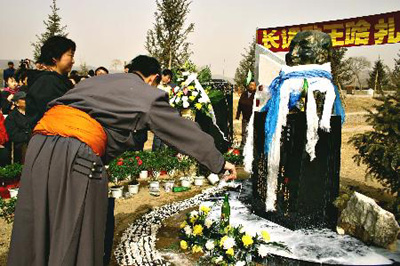| Tools: Save | Print | E-mail | Most Read |
| A Tribute to the Voice of the Mongolian Grasslands |
| Adjust font size: |
On March 19, hundreds packed the Gulin Humanity Memorial Park in Hohhot, Inner Mongolia, to pay tribute to Hajab, one of the century's greatest Mongolian vocalists. A ceremony was held to unveil the sculpture made to commemorate the king of the urtiin duu, a traditional Mongolian song. Among those who came to pay their respects were some of China's more celebrated musicians. Hajab died of a heart attack at age of 84 in his hometown Xilingol League in Inner Mongolia on October 27, 2005. In honor of the revered vocalist, renowned local sculptor, Yin Jintuo, set about sculpting a piece of art that he completed on January 18. According to a report from Xinhua News Agency, the 1.2-meter-high, 45-centimeter-wide bronze sculpture, weighing over 100 kg, cost Yin 400,000 yuan (US$49,800) to make. Speaking at the ceremony, Mergjih, a respected composer and music theorist, said: "Hajab is the guru of the contemporary urtiin duu music. He took Mongolian singing into a whole new dimension. Many young people have come here today to remember him and to carry on his mission of promoting this art form." On November 25, 2005, the United Nations Educational, Scientific and Cultural Organization (UNESCO) named the 43 new Masterpieces of the Oral and Intangible Heritages of Humanity. Urtiin duu, or the Mongolian traditional long song, which was jointly submitted by China and Mongolia for heritage protection, was one of the named masterpieces. Urtiin duu plays a very particular and honorable role in Mongolian society. It is sung during important festivals, occasions and rituals. It is a lyrical chant composed of 32 verses enveloped in rich melodies. At its very core is an expression of praise and awe of the beauty of the grasslands, love and destiny. The art form is believed to be about 2,000 years old. The earliest written records of it were made in the 13th century. Hajab is the only vocalist known to have mastered this ancient art form. He was born in a musical family in 1922 and started his singing career at the tender age of 11. It was he who first brought urtiin duu to the big stage, introducing it to domestic and international artistes alike, with well-received performances in North Korea, Mongolia, Sweden, Finland, former Soviet Union and Japan. Also known as the "People's Vocalist," Hajab developed his own singing style over the course of his long and esteemed career. He also standardized and regulated the urtiin duu, creating a unique Mongolian grasslands style of music. Under his tutelage, many of today's more popular folk singers including Dedema, Lasurong, Hu Songhua, and Qi Feng learned the finer points of urtiin duu. During his lifetime, Hajab produced about 100 songs, including 34 urtiin duus and 23 bogino duus, or short songs, another major form of Mongolian music. His most acclaimed works include A Fine Horse (audio), The Yellow Colt (audio) and Obugen Xibuu (audio). Remembering him at the ceremony last Sunday, family members, friends, professional musicians and fans adorned his sculpture with kha-btags ribbons (or traditional hada silk scarves). Oyunger, Hajab's adopted daughter, buried stones and earth from his hometown in front of the sculpture, and others poured milk under it as a mark of respect. And what better way to honor the father of the modern-day urtiin duu than with a rendition of one of his classics Genghis Khan? Singers Qi Feng and Dedema led the tribute that soon had everyone in the crowd joining in. This moving scene might have been a sign that there is hope for the continued survival of traditional Mongolian music. However, unbridled urbanization and industrialization since the 1950s have significantly altered the traditional nomadic lifestyles of the people of Inner Mongolia, the very lifeblood of urtiin duu. And efforts now to resuscitate that spirit might be too little too late.
(China.org.cn by Zhang Rui March 23, 2006) |
| Tools: Save | Print | E-mail | Most Read |
 |
| Related Stories |
|
| Product Directory China Search |
Country Search Hot Buys |

